 在 TensorFlow.org上查看 在 TensorFlow.org上查看 |
 在 Google Colab 中运行 在 Google Colab 中运行 |
 在 GitHub 上查看源代码 在 GitHub 上查看源代码 |
 下载笔记本 下载笔记本 |
本教程演示了如何使用深度卷积生成对抗网络 (DCGAN) 生成手写数字的图像。该代码是使用 Keras 序列式 API 与 tf.GradientTape 训练循环编写的。
什么是生成对抗网络?
生成对抗网络 (GAN) 是当今计算机科学领域最有趣的想法之一。两个模型通过对抗过程同时训练。生成器(“艺术家”)学习创建看起来真实的图像,而判别器(“艺术评论家”)学习区分真假图像。
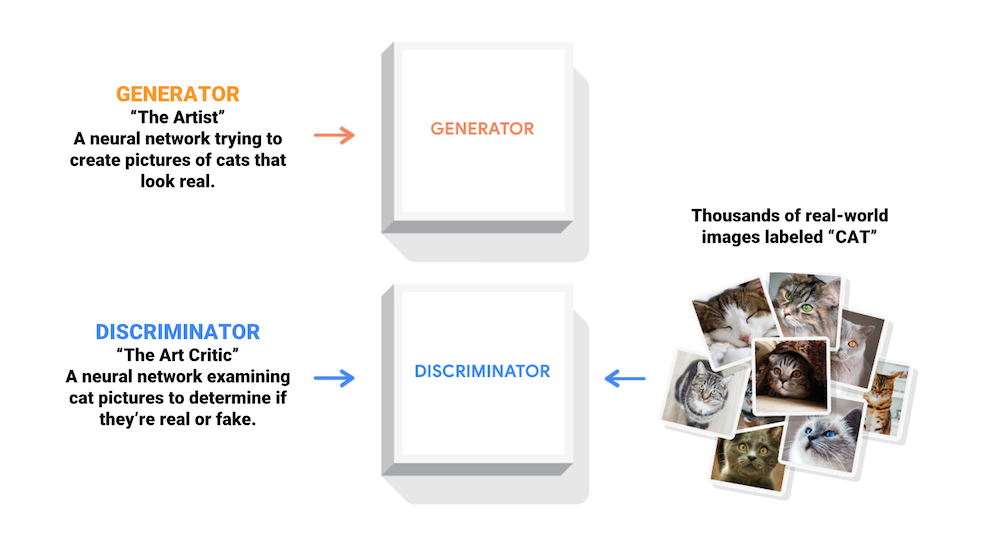
训练过程中,生成器在生成逼真图像方面逐渐变强,而判别器在辨别这些图像的能力上逐渐变强。当判别器不再能够区分真实图片和伪造图片时,训练过程达到平衡。

本笔记在 MNIST 数据集上演示了该过程。下方动画展示了当训练了 50 个epoch (全部数据集迭代50次) 时生成器所生成的一系列图片。图片从随机噪声开始,随着时间的推移越来越像手写数字。

要详细了解 GAN,请参阅 MIT 的深度学习介绍课程。
Import TensorFlow and other libraries
import tensorflow as tf
2023-11-07 19:20:53.713258: E external/local_xla/xla/stream_executor/cuda/cuda_dnn.cc:9261] Unable to register cuDNN factory: Attempting to register factory for plugin cuDNN when one has already been registered 2023-11-07 19:20:53.713309: E external/local_xla/xla/stream_executor/cuda/cuda_fft.cc:607] Unable to register cuFFT factory: Attempting to register factory for plugin cuFFT when one has already been registered 2023-11-07 19:20:53.714908: E external/local_xla/xla/stream_executor/cuda/cuda_blas.cc:1515] Unable to register cuBLAS factory: Attempting to register factory for plugin cuBLAS when one has already been registered
tf.__version__
'2.15.0-rc1'
# To generate GIFspip install imageiopip install git+https://github.com/tensorflow/docs
import glob
import imageio
import matplotlib.pyplot as plt
import numpy as np
import os
import PIL
from tensorflow.keras import layers
import time
from IPython import display
加载和准备数据集
您将使用 MNIST 数据集来训练生成器和判别器。生成器将生成类似于 MNIST 数据集的手写数字。
(train_images, train_labels), (_, _) = tf.keras.datasets.mnist.load_data()
train_images = train_images.reshape(train_images.shape[0], 28, 28, 1).astype('float32')
train_images = (train_images - 127.5) / 127.5 # Normalize the images to [-1, 1]
BUFFER_SIZE = 60000
BATCH_SIZE = 256
# Batch and shuffle the data
train_dataset = tf.data.Dataset.from_tensor_slices(train_images).shuffle(BUFFER_SIZE).batch(BATCH_SIZE)
创建模型
生成器和判别器均使用 Keras Sequential API 定义。
生成器
生成器使用 tf.keras.layers.Conv2DTranspose(上采样)层来从种子(随机噪声)中生成图像。以一个使用该种子作为输入的 Dense 层开始,然后多次上采样,直至达到所需的 28x28x1 的图像大小。请注意,除了输出层使用双曲正切之外,其他每层均使用 tf.keras.layers.LeakyReLU 激活。
def make_generator_model():
model = tf.keras.Sequential()
model.add(layers.Dense(7*7*256, use_bias=False, input_shape=(100,)))
model.add(layers.BatchNormalization())
model.add(layers.LeakyReLU())
model.add(layers.Reshape((7, 7, 256)))
assert model.output_shape == (None, 7, 7, 256) # Note: None is the batch size
model.add(layers.Conv2DTranspose(128, (5, 5), strides=(1, 1), padding='same', use_bias=False))
assert model.output_shape == (None, 7, 7, 128)
model.add(layers.BatchNormalization())
model.add(layers.LeakyReLU())
model.add(layers.Conv2DTranspose(64, (5, 5), strides=(2, 2), padding='same', use_bias=False))
assert model.output_shape == (None, 14, 14, 64)
model.add(layers.BatchNormalization())
model.add(layers.LeakyReLU())
model.add(layers.Conv2DTranspose(1, (5, 5), strides=(2, 2), padding='same', use_bias=False, activation='tanh'))
assert model.output_shape == (None, 28, 28, 1)
return model
使用(尚未训练的)生成器创建一张图片。
generator = make_generator_model()
noise = tf.random.normal([1, 100])
generated_image = generator(noise, training=False)
plt.imshow(generated_image[0, :, :, 0], cmap='gray')
<matplotlib.image.AxesImage at 0x7fe57c7c9d60>
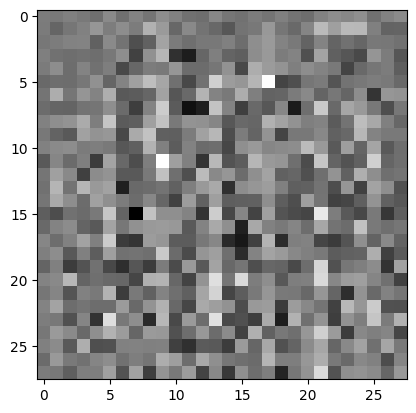
判别器
判别器是一个基于 CNN 的图片分类器。
def make_discriminator_model():
model = tf.keras.Sequential()
model.add(layers.Conv2D(64, (5, 5), strides=(2, 2), padding='same',
input_shape=[28, 28, 1]))
model.add(layers.LeakyReLU())
model.add(layers.Dropout(0.3))
model.add(layers.Conv2D(128, (5, 5), strides=(2, 2), padding='same'))
model.add(layers.LeakyReLU())
model.add(layers.Dropout(0.3))
model.add(layers.Flatten())
model.add(layers.Dense(1))
return model
使用(尚未训练的)判别器对所生成的图像进行真伪分类。模型将被训练为对真实图像输出正值,对伪造图像输出负值。
discriminator = make_discriminator_model()
decision = discriminator(generated_image)
print (decision)
tf.Tensor([[6.968534e-05]], shape=(1, 1), dtype=float32)
定义损失函数和优化器
为两个模型定义损失函数和优化器。
# This method returns a helper function to compute cross entropy loss
cross_entropy = tf.keras.losses.BinaryCrossentropy(from_logits=True)
判别器损失
该方法量化判别器从判断真伪图片的能力。它将判别器对真实图片的预测值与值全为 1 的数组进行对比,将判别器对伪造(生成的)图片的预测值与值全为 0 的数组进行对比。
def discriminator_loss(real_output, fake_output):
real_loss = cross_entropy(tf.ones_like(real_output), real_output)
fake_loss = cross_entropy(tf.zeros_like(fake_output), fake_output)
total_loss = real_loss + fake_loss
return total_loss
生成器损失
生成器的损失可量化其欺骗判别器的能力。直观地说,如果生成器表现良好,判别器会将伪造图像分类为真实图像(或 1)。在此,需要将判别器对生成图像的决策与值全为 1 的数组进行对比。
def generator_loss(fake_output):
return cross_entropy(tf.ones_like(fake_output), fake_output)
判别器和生成器优化器不同,因为您将分别训练两个网络。
generator_optimizer = tf.keras.optimizers.Adam(1e-4)
discriminator_optimizer = tf.keras.optimizers.Adam(1e-4)
保存检查点
本笔记还演示了如何保存和恢复模型,这在长时间训练任务被中断的情况下比较有帮助。
checkpoint_dir = './training_checkpoints'
checkpoint_prefix = os.path.join(checkpoint_dir, "ckpt")
checkpoint = tf.train.Checkpoint(generator_optimizer=generator_optimizer,
discriminator_optimizer=discriminator_optimizer,
generator=generator,
discriminator=discriminator)
定义训练循环
EPOCHS = 50
noise_dim = 100
num_examples_to_generate = 16
# You will reuse this seed overtime (so it's easier)
# to visualize progress in the animated GIF)
seed = tf.random.normal([num_examples_to_generate, noise_dim])
训练循环在生成器接收到一个随机种子作为输入时开始。该种子用于生成一个图像。判别器随后被用于对真实图像(选自训练集)和伪造图像(由生成器生成)进行分类。为每一个模型计算损失,并使用梯度更新生成器和判别器。
# Notice the use of `tf.function`
# This annotation causes the function to be "compiled".
@tf.function
def train_step(images):
noise = tf.random.normal([BATCH_SIZE, noise_dim])
with tf.GradientTape() as gen_tape, tf.GradientTape() as disc_tape:
generated_images = generator(noise, training=True)
real_output = discriminator(images, training=True)
fake_output = discriminator(generated_images, training=True)
gen_loss = generator_loss(fake_output)
disc_loss = discriminator_loss(real_output, fake_output)
gradients_of_generator = gen_tape.gradient(gen_loss, generator.trainable_variables)
gradients_of_discriminator = disc_tape.gradient(disc_loss, discriminator.trainable_variables)
generator_optimizer.apply_gradients(zip(gradients_of_generator, generator.trainable_variables))
discriminator_optimizer.apply_gradients(zip(gradients_of_discriminator, discriminator.trainable_variables))
def train(dataset, epochs):
for epoch in range(epochs):
start = time.time()
for image_batch in dataset:
train_step(image_batch)
# Produce images for the GIF as you go
display.clear_output(wait=True)
generate_and_save_images(generator,
epoch + 1,
seed)
# Save the model every 15 epochs
if (epoch + 1) % 15 == 0:
checkpoint.save(file_prefix = checkpoint_prefix)
print ('Time for epoch {} is {} sec'.format(epoch + 1, time.time()-start))
# Generate after the final epoch
display.clear_output(wait=True)
generate_and_save_images(generator,
epochs,
seed)
生成与保存图片
def generate_and_save_images(model, epoch, test_input):
# Notice `training` is set to False.
# This is so all layers run in inference mode (batchnorm).
predictions = model(test_input, training=False)
fig = plt.figure(figsize=(4, 4))
for i in range(predictions.shape[0]):
plt.subplot(4, 4, i+1)
plt.imshow(predictions[i, :, :, 0] * 127.5 + 127.5, cmap='gray')
plt.axis('off')
plt.savefig('image_at_epoch_{:04d}.png'.format(epoch))
plt.show()
训练模型
调用上面定义的 train() 方法来同时训练生成器和判别器。注意,训练 GANs 可能是棘手的。重要的是,生成器和判别器不能够互相压制对方(例如,他们以相似的学习率训练)。
在训练之初,生成的图片看起来像是随机噪声。随着训练过程的进行,生成的数字将越来越真实。在大概 50 个 epoch 之后,这些图片看起来像是 MNIST 数字。使用 Colab 中的默认设置可能需要大约 1 分钟每 epoch。
train(train_dataset, EPOCHS)
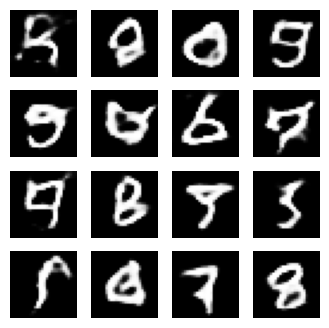
恢复最新的检查点。
checkpoint.restore(tf.train.latest_checkpoint(checkpoint_dir))
<tensorflow.python.checkpoint.checkpoint.CheckpointLoadStatus at 0x7fe57d1a68b0>
创建 GIF
# Display a single image using the epoch number
def display_image(epoch_no):
return PIL.Image.open('image_at_epoch_{:04d}.png'.format(epoch_no))
display_image(EPOCHS)
--------------------------------------------------------------------------- KeyError Traceback (most recent call last) File /tmpfs/src/tf_docs_env/lib/python3.9/site-packages/PIL/JpegImagePlugin.py:639, in _save(im, fp, filename) 638 try: --> 639 rawmode = RAWMODE[im.mode] 640 except KeyError as e: KeyError: 'RGBA' The above exception was the direct cause of the following exception: OSError Traceback (most recent call last) File /tmpfs/src/tf_docs_env/lib/python3.9/site-packages/PIL/Image.py:643, in Image._repr_image(self, image_format, **kwargs) 642 try: --> 643 self.save(b, image_format, **kwargs) 644 except Exception as e: File /tmpfs/src/tf_docs_env/lib/python3.9/site-packages/PIL/Image.py:2413, in Image.save(self, fp, format, **params) 2412 try: -> 2413 save_handler(self, fp, filename) 2414 except Exception: File /tmpfs/src/tf_docs_env/lib/python3.9/site-packages/PIL/JpegImagePlugin.py:642, in _save(im, fp, filename) 641 msg = f"cannot write mode {im.mode} as JPEG" --> 642 raise OSError(msg) from e 644 info = im.encoderinfo OSError: cannot write mode RGBA as JPEG The above exception was the direct cause of the following exception: ValueError Traceback (most recent call last) File /tmpfs/src/tf_docs_env/lib/python3.9/site-packages/IPython/core/formatters.py:344, in BaseFormatter.__call__(self, obj) 342 method = get_real_method(obj, self.print_method) 343 if method is not None: --> 344 return method() 345 return None 346 else: File /tmpfs/src/tf_docs_env/lib/python3.9/site-packages/PIL/Image.py:661, in Image._repr_jpeg_(self) 656 def _repr_jpeg_(self): 657 """iPython display hook support for JPEG format. 658 659 :returns: JPEG version of the image as bytes 660 """ --> 661 return self._repr_image("JPEG") File /tmpfs/src/tf_docs_env/lib/python3.9/site-packages/PIL/Image.py:646, in Image._repr_image(self, image_format, **kwargs) 644 except Exception as e: 645 msg = f"Could not save to {image_format} for display" --> 646 raise ValueError(msg) from e 647 return b.getvalue() ValueError: Could not save to JPEG for display
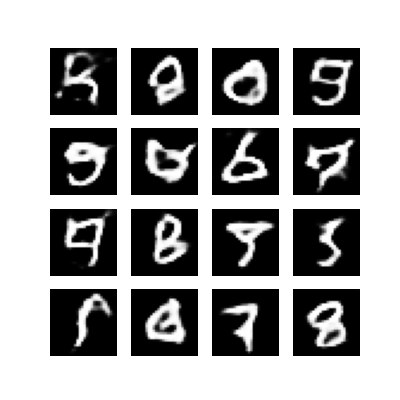
使用训练过程中生成的图片通过 imageio 生成动态 gif
anim_file = 'dcgan.gif'
with imageio.get_writer(anim_file, mode='I') as writer:
filenames = glob.glob('image*.png')
filenames = sorted(filenames)
for filename in filenames:
image = imageio.imread(filename)
writer.append_data(image)
image = imageio.imread(filename)
writer.append_data(image)
/tmpfs/tmp/ipykernel_435330/1982054950.py:7: DeprecationWarning: Starting with ImageIO v3 the behavior of this function will switch to that of iio.v3.imread. To keep the current behavior (and make this warning disappear) use `import imageio.v2 as imageio` or call `imageio.v2.imread` directly. image = imageio.imread(filename) /tmpfs/tmp/ipykernel_435330/1982054950.py:9: DeprecationWarning: Starting with ImageIO v3 the behavior of this function will switch to that of iio.v3.imread. To keep the current behavior (and make this warning disappear) use `import imageio.v2 as imageio` or call `imageio.v2.imread` directly. image = imageio.imread(filename)
import tensorflow_docs.vis.embed as embed
embed.embed_file(anim_file)
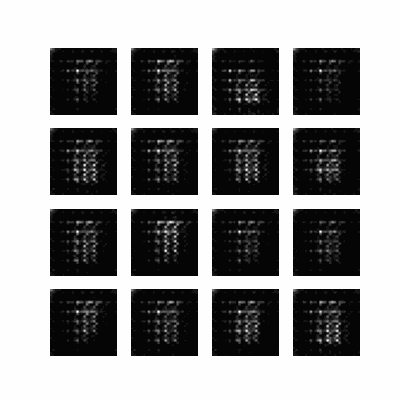
下一步
本教程展示了编写和训练 GAN 所需的完整代码。下一步,您可能想尝试不同的数据集,例如 Kaggle 上提供的 Large-scale Celeb Faces Attributes (CelebA) 人脸识别数据集。要详细了解 GAN,请参阅 NIPS 2016 教程:生成对抗网络。
